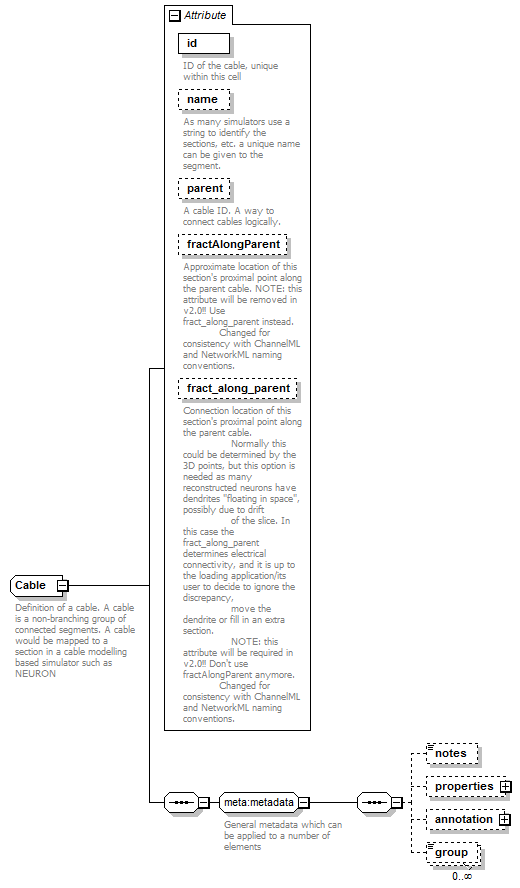<xs:complexType name="Cable">
<xs:annotation>
<xs:documentation>Definition of a cable. A cable is a non-branching group of connected segments. A cable would be mapped to a section in a cable modelling based simulator such as NEURON</xs:documentation>
</xs:annotation>
<xs:sequence>
<xs:group ref="meta:metadata"/>
</xs:sequence>
<xs:attribute name="id" type="xs:nonNegativeInteger" use="required">
<xs:annotation>
<xs:documentation>ID of the cable, unique within this cell</xs:documentation>
</xs:annotation>
</xs:attribute>
<xs:attribute name="name" type="xs:string" use="optional">
<xs:annotation>
<xs:documentation>As many simulators use a string to identify the sections, etc. a unique name can be given to the segment.</xs:documentation>
</xs:annotation>
</xs:attribute>
<xs:attribute name="parent" type="xs:nonNegativeInteger" use="optional">
<xs:annotation>
<xs:documentation>A cable ID. A way to connect cables logically.</xs:documentation>
</xs:annotation>
</xs:attribute>
<xs:attribute name="fractAlongParent" type="meta:ZeroToOne" use="optional">
<xs:annotation>
<xs:documentation>Approximate location of this section's proximal point along the parent cable. NOTE: this attribute will be removed in v2.0!! Use fract_along_parent instead. Changed for consistency with ChannelML and NetworkML naming conventions.</xs:documentation>
</xs:annotation>
</xs:attribute>
<xs:attribute name="fract_along_parent" type="meta:ZeroToOne" use="optional">
<xs:annotation>
<xs:documentation>Connection location of this section's proximal point along the parent cable. Normally this could be determined by the 3D points, but this option is needed as many reconstructed neurons have dendrites "floating in space", possibly due to drift of the slice. In this case the fract_along_parent determines electrical connectivity, and it is up to the loading application/its user to decide to ignore the discrepancy, move the dendrite or fill in an extra section. NOTE: this attribute will be required in v2.0!! Don't use fractAlongParent anymore. Changed for consistency with ChannelML and NetworkML naming conventions.</xs:documentation>
</xs:annotation>
</xs:attribute>
</xs:complexType> |
